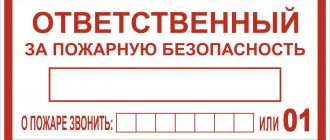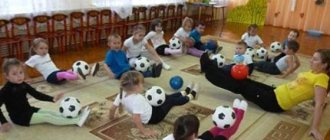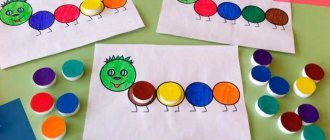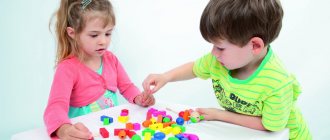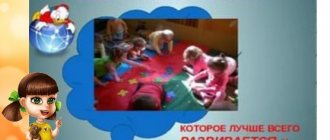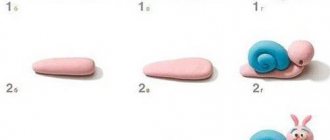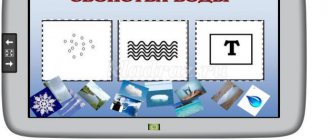The purpose of the didactic game “Dangerous Objects”
The goal is to form and consolidate knowledge about what objects are potentially dangerous to humans and how to handle them.
Tasks:
- identification of dangerous household items, identifying them in the environment;
- acquiring the skill of using them safely;
- developing an understanding of dangerous situations, ways to prevent them, rules of conduct in case of an emergency;
- consolidation of the concepts of “danger”, “safety”, “caution”;
- development of intelligence, visual perception, reaction speed, ability to think logically, and argue one’s opinion;
- fostering responsibility and independence.
Junior group
We offer games on the theme “Dangerous Objects” for younger preschoolers.
Dangerous household items
The game is a lotto. For it you need to prepare a table with cells depicting dangerous things, as well as corresponding cards.
The teacher reads a poem or riddle about the subject. The students, having guessed what this thing is, choose a card and cover the picture in the table cell with it.
Green or red
For this lesson you need to prepare two large circles: green and red. It is also necessary to cut out small circles depicting dangerous and safe things.
The teacher lays out the pictures in front of the players. They carefully examine the images, discuss the purpose and degree of danger of the drawn objects. Then they arrange the pictures around large circles, like petals around the core of a flower. Objects that are dangerous are placed in the red circle, and items that are completely safe to use are placed in the green circle.

Dangers
The game reinforces the idea of what dangers a preschooler can face in everyday life, how to deal with them, and how to act correctly. The activity also teaches empathy and fosters a desire to help people in trouble. It is necessary to prepare plot pictures depicting various dangerous situations that can happen to a preschooler at home, in the yard, or in nature.
The teacher places the pictures face down. Pupils take turns taking a card at random, look at the depicted plot, tell what they see, why such a situation happened to the child, what he did wrong, how to correct the mistake, how to act.
What are the rules for playing Children's Dominoes?
The rules of the game "Children's Dominoes" allow two people to play, but even more interest and fun arises when four players participate in the game.
The rules of the game "Children's Dominoes" are similar to the adult counterpart of the game, but a little simpler:
- The game is played with dominoes (chips). In the children's version, dominoes are dedicated to animals, plants, fruits, cars, the alphabet, etc. It’s better to talk about these objects along the way and the child will definitely remember not only the names, but also the educational stories.
- There are a total of 28 dice in the set, of which 7 are duplicates and 21 are adjacent dice. If there are two players, then they receive 7 dominoes, and when there are four players, they receive 5 dominoes.
- The remaining dominoes lie in the “bank” with the images facing down. The participant takes a chip from the “bank” if there is no one needed for a move.
- The player goes first if there is a domino - a “double”, with a paired image. For example, watermelon - watermelon or hare - hare.
- The next participant places a chip so that the picture matches one of the pictures on the player’s domino. For example, watermelon is a pear. Another step is a pear domino.
- If the participant does not have the required option, they need to contact the bank. However, you need to pull out chips until the right one appears. If there is no such chip anymore, skip the move. This is the famous “fish” - there is no necessary domino to move when you have them on your hands.
- The winner is the player who is out of chips the fastest.
Children of all ages, even one-year-olds, can participate in the game “Children's Dominoes”. It is better for an older child to offer an adult domino with dots to develop the skill of counting the number of dots. Little children like to make piles, paths, paths from dominoes, and build houses.
To play dominoes, you need to pay attention to the material of the dominoes. The best option is wooden dominoes; they can be placed on either side. The plastic domino pieces are falling apart due to the seams. There are cardboard dominoes, but in children they quickly fail.
The main thing to remember is that the upbringing and development of children is possible by example. And the tradition of staying up in the evenings with an exciting activity will create not only a pleasant and friendly atmosphere in the house, but also a joint ritual that the grandchildren will follow, and the game “Children's Dominoes” will be an excellent solution for organizing leisure time for children.

For useful and fun leisure time, a website has been created where you can get acquainted with the clear rules of various games, for example, etc.
You can easily find any game or page on our resource. To do this, you need to use it - it is very convenient and understandable.
Development of mental operations
Purpose of the game
- development of mental operations: generalization, exclusion.
The board game "Dominoes" allows you to solve the following problems:
- Develops mental operations of generalization and exclusion;
- Reinforces ideas on lexical topics of the preschool program;
- Train fine motor skills of the hands;
- Develops humanistic qualities of the individual: mutual assistance, cooperation, value of knowledge.
The game is designed for children of the senior and preparatory groups of preschool institutions who experience difficulties in the development of mental operations.
The game can be played individually or in small subgroups.
The presented game integrates the educational areas of the Federal State Educational Standard for Preschool Education, allowing you to comprehensively solve the problems of the standard in the field of cognitive and socio-communicative development.
The peculiarity of the game is its execution; the “stones” of dominoes are really stones with designs coated with varnish. Unusual material increases the child's interest, while being an environmentally friendly and affordable material.
Description of the game progress
. Participants in the game are invited to help the prince or princess get home, but to do this they need to build a path of domino “stones”. The stones need to be laid according to the principle of ordinary dominoes: it is necessary to build a chain-path, the halves touching, but not with the same pictures, but with pictures of the same theme. For example, a “skirt” may be suitable for “jacket”, because both pictures are “clothes”. The child must explain his choice, strengthening his generalization abilities and knowledge. The game ends when the entire path of “stones” has been built and the princess/prince can come home by stepping on each stone in the path.
Didactic game for children of the senior preparatory group in kindergarten “Mathematical Domino”
Natalya Evgenievna Khokhlova Place of work: MKDOU No. 18, Miass, Chelyabinsk region Position: teacher-speech pathologist Name of the resource: board-printed didactic game “Mathematical Domino” Brief description of the resource: a game for children 5 – 7 years old to develop basic mathematical concepts and develop logical thinking.
The purpose and objectives of the resource: development of the ability to understand the meaning of addition and subtraction, and mathematical signs “+”, “-” within ten; development of logical thinking, visual perception. Relevance and significance of the resource: the game can be used by speech therapists, defectologists, and parents in correctional work with children. Equipment: the game is played using a PC (personal computer) and consists of cut domino cards. Practical application: individual lessons, frontal correction lessons (as a demonstration of a task or a direct game “one at a time”). Methodology for working with the resource:
1. Individually: the child takes domino cards and builds a logical chain. 2. Front: used to demonstrate a task using a magnetic board and magnets; Children in their seats work orally and frontally.
Teaching elementary mathematical concepts to older preschool children is a challenging task. To captivate a child, mathematical educational material must be presented to him in a playful way. And didactic games will help with this in the best possible way, which will allow children to familiarize children with numbers, numbers, the basics of counting, and arithmetic operations in an easy playful way. The presented game will allow you and your child to remember new information and, with the help of clarity, consolidate the material being studied.
Option I
In front of you on the playing field are domino cards, on some halves of which various numbers are written, and on the other - arithmetic operations for addition. You need to arrange the cards so that with each arithmetic operation you get a number that makes sense. To do this, of course, you need to correctly solve all the examples, find the half with the answer and substitute it next to it.
Option II
The presented domino cards are printed and cut.
In front of you on the playing field are domino cards, on some halves of which various numbers are written, and on the other - arithmetic operations for subtraction. You need to arrange the cards so that with each arithmetic operation you get a number that makes sense. To do this, of course, you need to correctly solve all the examples, find the half with the answer and substitute it next to it. Alternatively, you can use domino cards to combine the arithmetic operations of addition and subtraction.
Option III
The presented colored domino cards are printed and cut. This version of the domino game will help you test how well your child can count and whether he is familiar with geometric shapes.
In front of you on the playing field are domino cards, on some halves of which various numbers are written, and on the other - geometric shapes. You need to arrange the cards so that with each geometric figure there is a number that is suitable in meaning. To do this, you need to count the number of angles for each geometric figure.
I hope that this resource will help you and your child consolidate their knowledge of mathematics. I wish you success!
Once upon a time, entire generations grew up listening to the clatter of dominoes in the yard. And boxes with chess, checkers and lotto took pride of place in almost every apartment. Today, computers and television have pushed board games into the background. But experts say: by erasing the passion for intellectual games from our lives, we are depriving ourselves of enormous opportunities. After all, board games are both therapy and the development of skills necessary for competent management of your life.
Chess. Gymnastics of the mind
A LOGICAL game that combines elements of art, science and sports. One of the oldest games on Earth. Chess promotes the development of mental abilities, memory, and creative thinking. They teach you to develop multi-move combinations in your mind.
Go. Craving for philosophy
More than 50 million people play GO. This game develops systematic thinking, the ability to think strategically and develop tactics. The game also inclines a person to philosophize. The point is that people who play Go deal with images. A blurry image of a pattern of stones formed on a board spins in a person’s head and mysteriously influences the fuzzy logic of decision-making. They say that this is why a computer is not yet able to beat a person at this game.
Checkers. Ways of thinking
LIKE chess, checkers reproduce the actions of forces fighting according to certain rules. The game develops combinatorics of thinking (the ability to think in sets of images).
Shogi (Japanese chess). Game of feelings
THEY SAY that in order to make the correct winning move in shogi, you need to feel it. Even in ancient times, shogi in Japan was recognized as a game that developed strategic and tactical military thinking. In Japan, this game has been elevated to the rank of shrines; in many schools it is included in the compulsory curriculum. And although few people in Ukraine have even heard of shogi, it was a Ukrainian who became the champion of Europe and the Open World Championship in 2008.
Domino. Let's understand the structure of the universe
THEY SAY that dominoes were originally intended exclusively for fortune telling and magical ceremonies. It is even suggested that the dominant system of the universe is encrypted in dominoes - the Universal Law of Harmony of the macro- and microcosmos. And even the newfound name of the game, “slaughtering a goat,” does not detract from its merits. Dominoes develop focus, concentration, logical thinking, the ability to analyze a situation, attentiveness, observation and memory.
"Cash Flow" (CashFlow). Business game
“CASHFLOW” is a modern adult version of the well-known “Monopoly”. A specially trained trainer can teach you how to play Cash-Flow. Supporters of the game claim that the money spent on training (about 100 UAH) will very soon pay off. After all, the game allows the player to analyze his life and financial mistakes, realize them, and then correct them in the real world.
Backgammon
THIS ancient eastern game had a special meaning for the Persians: it symbolized the movement of the stars and served as a subject for fortune telling. In addition, based on the results of the game, partners often resolved commercial disputes: the winner dictated his terms to the loser. This happened because, according to the Persians, only a person whom fate loves (sends a “good stone” - suitable numbers on the dice), who knows how to think logically and see through the enemy, foreseeing his possible moves and blocking their negative consequences in advance, could win at backgammon.
Cards
EACH card game is a separate world. And almost every one is useful for something: preference and “fool” train the mind, the ability to calculate the situation in advance and memory, and such “children’s games” as “witch” and “hello, jack” can turn players into real psychologists who can concentrate as much as possible at the right moment.
BY THE WAY
Today, the Federation of Board Games of Ukraine is trying to restore its former glory to board games. And even the dominance of computer games does not frighten federation activists. “Due to the intensive development of computer games, board games are now in a period of decline,” notes Denis Krasnokutsky, head of the department of public events at the Federation of Board Games of Ukraine. “But a person’s imagination will not allow this to happen; they will be able to be reborn.” We strive to expand people's understanding of board games through special projects, and we plan to open intellectual clubs in every school. And in the near future, going to a cafe or bar, over a cup of tea, every visitor will be able to have a good time with friends, playing their favorite board game. We can say that we are creating a new culture, where sociability, intelligence and other human qualities that can be demonstrated and improved while playing will again be welcomed.”
Middle group
We present games on the theme “Dangerous Objects” for preschoolers of the middle age group.
Dangerous situations
For the lesson you need a sectorally divided circle, like the wheel in “Field of Miracles”. There should be 12 sectors, each with a corresponding number. The numbers should alternate in random order. On each sector you need to put a card depicting an emergency situation that a child may encounter at home, in kindergarten, in nature, or while walking.
Pupils take turns pulling out a card with a number from the bag. Find the corresponding sector. They look at the dropped plot picture, tell what is depicted, why this happened, and how to correct the situation.
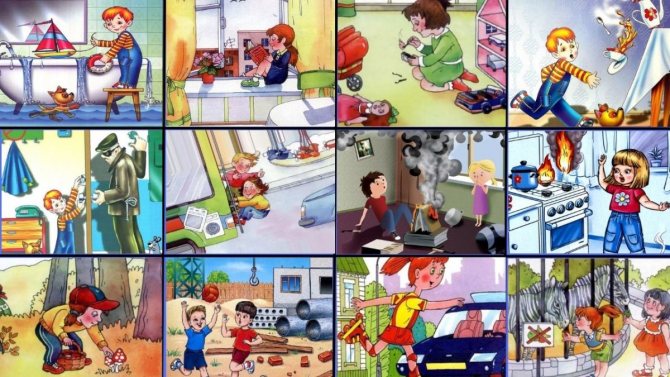
Didactic game “Dangerous and safe objects”
The game is organized in the form of dominoes, and a group of 2 to 18 children participates. Players distribute cards. Using a counting rhyme or some other method, the player who starts the game is determined. He places any of the available cards. It shows an object on the right, and a picture on the left, symbolizing how a child should use this thing. There are three options:
- can be used under adult supervision;
- cannot be used - it is a dangerous thing;
- You can use it yourself - it’s a safe thing.
The player chooses how the depicted object can be used, gives reasons for the choice, and draws a conclusion whether the thing is dangerous or not dangerous. The player who was quicker than his comrades to determine which picture is needed puts down the card. The game continues until all the cards are placed correctly.
Why is a thing dangerous?
The game expands the understanding of how to behave correctly in everyday life, develops concentration, and fosters a spirit of mutual assistance. For the lesson, you need cards depicting various injuries: a cut, a hematoma, a fracture, a burn, a puncture. Images of household items are also needed.
Children sort out cards depicting injuries. The teacher takes turns showing pictures of things. Players must figure out what kind of injury can be caused by using the item shown. The player who has the corresponding image raises his hand, tells how dangerous the thing being demonstrated is, how to handle it correctly, then takes the card.
Didactic games “Be careful, Baby!” (for children 5-7 years old)
Description of material:
This material will be useful to kindergarten teachers, additional education teachers, and parents of students. These games are aimed at developing in children the skills of careful handling of household appliances and understanding the need to comply with fire safety rules.
Crossword puzzle “Spark the carcass before the fire, avert trouble before the blow”
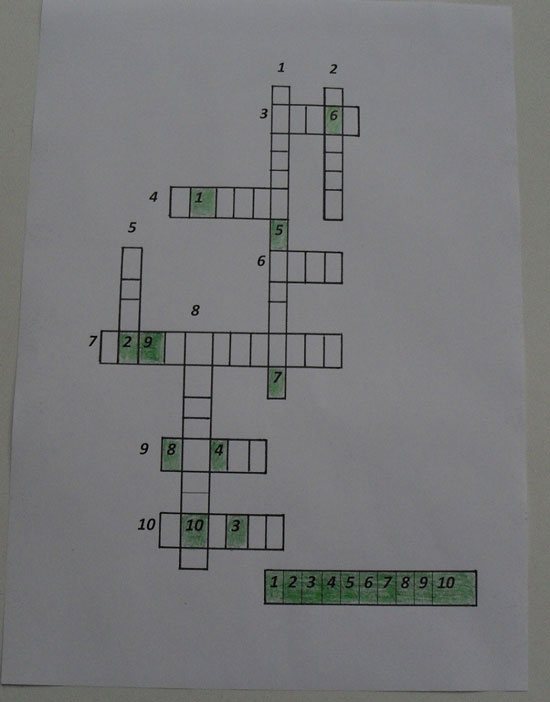
Target:
Introduce children to objects and phenomena that can cause a fire.
Tasks:
To develop in children basic knowledge about the dangers of playing with flammable objects; instill in children a sense of self-preservation.
Material:
Crossword puzzle on a sheet of A-4 size for each child, felt-tip pens, illustrations: various electrical appliances, candle, matches, fire, sparks, oven, lightning.
Progress of the game:
Educator.
How do you understand the proverb “Spark the carcass before the fire, avert trouble before the blow”? (Children's answers.)
Educator.
Why do fires occur? A crossword puzzle will help us answer this question.
Children sit at the tables on which the crossword puzzle is located.
Children solve a crossword puzzle using illustration clues. Before filling out the crossword puzzle, children's attention is drawn to the word that needs to be guessed by putting the letters in accordance with the numbers.
Horizontally:
3. The house is a glass bubble, and a light lives in it.
During the day it sleeps, but when it wakes up, it lights up with a bright flame. (Lamp)
4. At the rest stop he helped us: he cooked soup and baked potatoes.
It’s good for a hike, but you can’t take it with you. (Bonfire)
6. In the hut there is a hut, in the hut there is a pipe. There was a noise in the hut, a hum in the chimney.
People see the flames, but don’t go to put them out. (Bake)
7. It hangs and is silent, but when you turn it over, it hisses and the foam flies. (Fire extinguisher)
9. The head burns with fire, the body melts and burns
It can melt, but it’s not the ice, not the lantern, but it gives light. (Candle)
10. He shoots fiery arrows, no one will catch them. (Lightning)
Vertically:
1. Only me, only me, I’m in charge in the kitchen, no matter how hard you work without me, you’ll be satiated without lunch. (Electric stove)
2. She only scratched her head on her cramped house.
And immediately - as if the poor thing had not lived, it burned to the ground. (Match)
5. In a linen country, a steamboat floats along a sheet river, now back and forth,
And behind it there is such a smooth surface, not a wrinkle can be seen. (Iron)
8. The whole universe lives in it, but it is an ordinary thing. (TV)
"The Fourth Wheel"
Target:
To develop the ability to compare objects and identify an object that is dangerous to life and health.
Tasks:
• Develop verbal and logical thinking, the ability to classify, compare, generalize, establish cause-and-effect and logical relationships.
• Develop visual perception.
• Develop monologue and dialogic speech.
• Cultivate attentiveness, the ability to accurately follow instructions; determination.
Material:
square cards with images of four objects: those that cause fire, objects that cannot be taken, that require careful handling, square cards the size of one picture
Game content:
Invite the children to look carefully and determine what is drawn in excess, and explain why. In the picture you need to find an image that does not fit the other three.
For example:
Three images belong to the concept of “safe objects”, and the picture with the image of a needle or scissors belongs to the classification “dangerous”, which means the needle is an extra object. Whoever is the first to cover the extra item on the cards correctly wins.

“Fire hazardous places in the apartment”
Target:
To form in children an idea of objects that are dangerous to life and health that they encounter in everyday life.
Tasks:
Promote the development of caution and prudence
Develop logical thinking, attention, and the ability to draw conclusions.
Material:
Approximate diagrams of rooms, signs - dangerous, safe.
Contents of the game:
The teacher offers children an image of different rooms of the apartment: kitchen, children's room, bathroom, etc., in which household items are located.
Educator:
Look carefully at the picture and identify items in it that children can use independently and identify those items that may be dangerous. Place signs near them: “Danger”, “Safe”.
For example:
Washing powder and dishwashing detergent are chemicals, you can get poisoned, we put a danger sign. The winner is the one who places the signs correctly without missing objects.
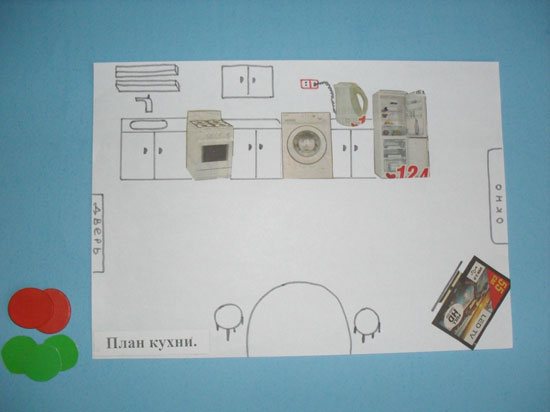
"The game is a serious matter"
Target:
To give children an understanding of dangerous and safe objects in the world around them.
Tasks:
To develop the ability to realistically assess the possible danger from surrounding objects.
Develop speech activity during the game.
Foster a sense of caution and self-preservation.
Material:
Danger and safety signs, pictures of objects (ball, book, car, doll, builder, album, pencil, pills, iron, matches, lighter, computer, knife, needle, washing powder), boxes with sticky signs: “Danger” , “Safe”, top with arrow.
Progress of the game:
Educator:
You guys have grown big and will soon go to school, what will they call you? (First graders, schoolchildren.)
Educator:
In first grade, many will have to stay home alone. Which one of you did your parents leave at home alone? (Children's answers.)
Educator:
If you've already been alone at home, then you know the safety rules. What dangers might there be at home? (Children's answers).
Educator:
Well done, you noticed very well all the dangers in objects. What items in the house can be considered dangerous? (Children's answers.)
Educator:
Help me choose items to play with when left alone at home. (Children's answers.)
Educator:
Look what I have. What do you think this is? (Children's answers.)
(Playing field with cards, with images of objects, a top with an arrow).
Educator:
We spin the top one by one, take the card that the arrow points to. We carefully examine it and determine which box we will put it in and with which sign. Why?
Children:
The iron is drawn, you cannot turn on electrical appliances - they can cause an electric shock or cause a fire. Box with a dangerous sign.
Educator:
Well done, you and I have identified dangerous and safe items for ourselves.

